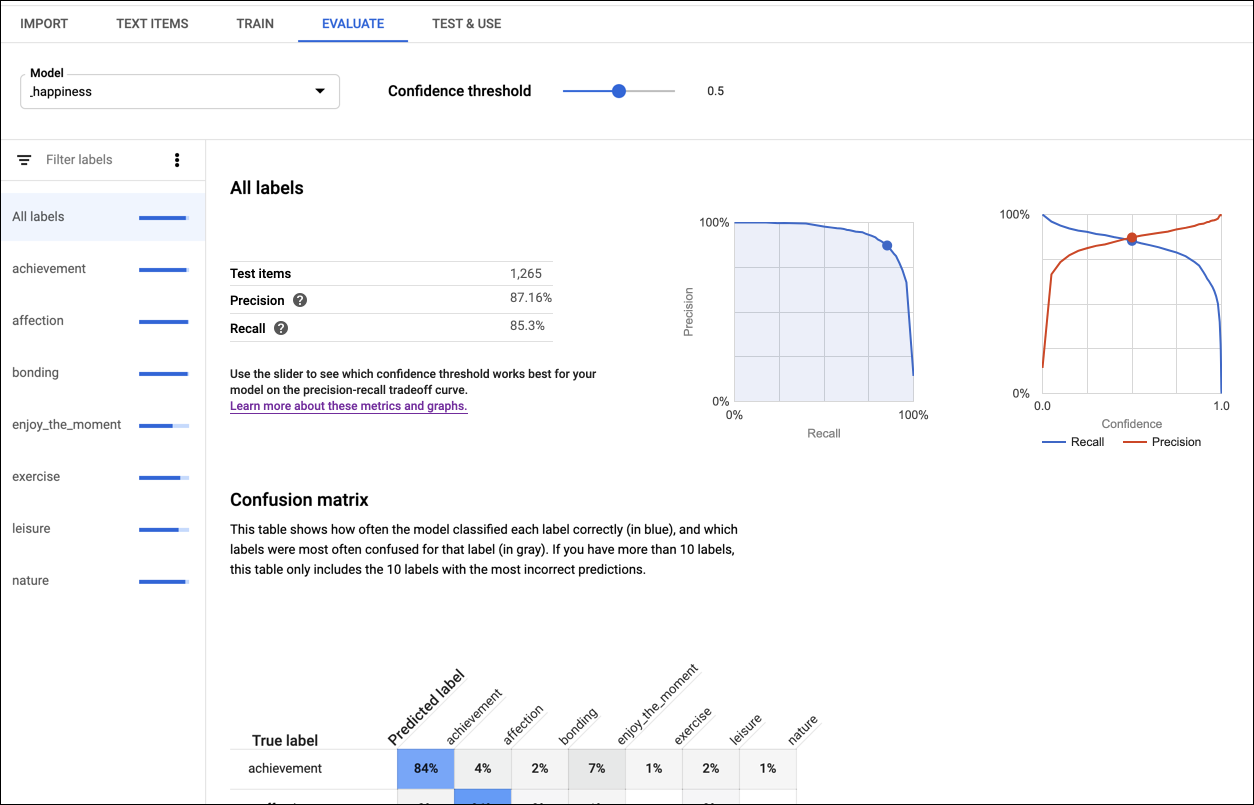在训练模型后,AutoML Natural Language 使用 TEST 集中的文档来评估新模型的质量和准确率。
AutoML Natural Language 提供了一组总体评估指标以及每个类别标签的评估指标。前者指示模型的整体表现情况,后者指示模型对该标签的执行情况。
精确率和召回率用于衡量模型捕获信息的情况以及丢失的信息量。精确率表示在标识为特定实体或标签的所有文档中,实际有多少文档应分配给该实体或标签。召回率表示在应被识别为特定实体或标签的所有文档中,实际有多少文档分配给了该实体或标签。
混淆矩阵(仅适用于每个文档只有一个标签的模型)表示评估期间每个标签被预测为训练集内相应标签的次数百分比。理想情况下,标签 one 只会分配给归类为 one 标签的文档,以此类推;因此,完美的矩阵应如下所示:
100 0 0 0
0 100 0 0
0 0 100 0
0 0 0 100
在上面的示例中,如果文档归类为 one,但模型预测为 two,则第一行将变为如下所示:
99 1 0 0
AutoML Natural Language 最多为 10 个标签创建混淆矩阵。 如果标签数量超过 10 个,则该矩阵会包含最容易混淆(预测错误)的 10 个标签。
对于情感模型:
平均绝对误差 (MAE) 和均方误差 (MSE) 衡量预测情感值与实际情感值之间的偏差。数值越低,表示模型越准确。
线性加权 kappa 和二次加权 kappa 衡量模型分配的情感值与人工标注者分配的情感值的接近程度。数值越高,表示模型越准确。
您可利用这些指标来评估您的模型的准备情况。如果精确率和召回率得分低,这可能表明您的模型需要额外的训练数据或者模型注释不一致。完美的精确率和召回率可能表明数据过于简单,模型可能无法有效泛化。如需查看有关评估模型的更多提示,请参阅新手指南。
如果您对质量水平不满意,则可以重新执行前述步骤以提高质量:
- 考虑为任何低质量的标签添加更多文档。
- 您可能需要添加不同类型的文档。例如,篇幅更长或更短的文档,不同作者使用不同措辞或风格撰写的文档。
- 您可以清理标签。
- 如果训练图片不够,请考虑完全移除相应标签。
一旦进行了更改,请训练并评估新模型,直到达到足够高的质量水平为止。
网页界面
如需查看模型的评估指标,请执行以下操作:
点击左侧导航栏中的灯泡图标以显示可用的模型。
如需查看其他项目的模型,请从标题栏右上角的下拉列表中选择该项目。
点击待评估模型所在的行。
如果需要,请点击标题栏正下方的评估标签。
如果该模型已完成训练,则 AutoML Natural Language 会显示其评估指标。

如要查看特定标签的指标,请从页面下部的标签列表中选择标签名称。
代码示例
这些示例为整个模型提供了评估。您还可以使用评估 ID 获取特定标签 (displayName) 的指标。
REST
在使用任何请求数据之前,请先进行以下替换:
- project-id:您的项目 ID
- location-id:资源的位置,全球位置为
us-central1,欧盟位置为eu - model-id:您的模型 ID
HTTP 方法和网址:
GET https://automl.googleapis.com/v1/projects/project-id/locations/location-id/models/model-id/modelEvaluations
如需发送您的请求,请展开以下选项之一:
您应该收到类似以下内容的 JSON 响应:
{
"modelEvaluation": [
{
"name": "projects/434039606874/locations/us-central1/models/7537307368641647584/modelEvaluations/9009741181387603448",
"annotationSpecId": "17040929661974749",
"classificationMetrics": {
"auPrc": 0.99772006,
"baseAuPrc": 0.21706384,
"evaluatedExamplesCount": 377,
"confidenceMetricsEntry": [
{
"recall": 1,
"precision": -1.3877788e-17,
"f1Score": -2.7755576e-17,
"recallAt1": 0.9761273,
"precisionAt1": 0.9761273,
"f1ScoreAt1": 0.9761273
},
{
"confidenceThreshold": 0.05,
"recall": 0.997,
"precision": 0.867,
"f1Score": 0.92746675,
"recallAt1": 0.9761273,
"precisionAt1": 0.9761273,
"f1ScoreAt1": 0.9761273
},
{
"confidenceThreshold": 0.1,
"recall": 0.995,
"precision": 0.905,
"f1Score": 0.9478684,
"recallAt1": 0.9761273,
"precisionAt1": 0.9761273,
"f1ScoreAt1": 0.9761273
},
{
"confidenceThreshold": 0.15,
"recall": 0.992,
"precision": 0.932,
"f1Score": 0.96106446,
"recallAt1": 0.9761273,
"precisionAt1": 0.9761273,
"f1ScoreAt1": 0.9761273
},
{
"confidenceThreshold": 0.2,
"recall": 0.989,
"precision": 0.951,
"f1Score": 0.96962786,
"recallAt1": 0.9761273,
"precisionAt1": 0.9761273,
"f1ScoreAt1": 0.9761273
},
{
"confidenceThreshold": 0.25,
"recall": 0.987,
"precision": 0.957,
"f1Score": 0.9717685,
"recallAt1": 0.9761273,
"precisionAt1": 0.9761273,
"f1ScoreAt1": 0.9761273
},
...
],
},
"createTime": "2018-04-30T23:06:14.746840Z"
},
{
"name": "projects/434039606874/locations/us-central1/models/7537307368641647584/modelEvaluations/9009741181387603671",
"annotationSpecId": "1258823357545045636",
"classificationMetrics": {
"auPrc": 0.9972302,
"baseAuPrc": 0.1883289,
...
},
"createTime": "2018-04-30T23:06:14.649260Z"
}
]
}
Python
如需了解如何安装和使用 AutoML Natural Language 的客户端库,请参阅 AutoML Natural Language 客户端库。 如需了解详情,请参阅 AutoML Natural Language Python API 参考文档。
如需向 AutoML Natural Language 进行身份验证,请设置应用默认凭据。如需了解详情,请参阅为本地开发环境设置身份验证。
Java
如需了解如何安装和使用 AutoML Natural Language 的客户端库,请参阅 AutoML Natural Language 客户端库。 如需了解详情,请参阅 AutoML Natural Language Java API 参考文档。
如需向 AutoML Natural Language 进行身份验证,请设置应用默认凭据。如需了解详情,请参阅为本地开发环境设置身份验证。
Node.js
如需了解如何安装和使用 AutoML Natural Language 的客户端库,请参阅 AutoML Natural Language 客户端库。 如需了解详情,请参阅 AutoML Natural Language Node.js API 参考文档。
如需向 AutoML Natural Language 进行身份验证,请设置应用默认凭据。如需了解详情,请参阅为本地开发环境设置身份验证。
Go
如需了解如何安装和使用 AutoML Natural Language 的客户端库,请参阅 AutoML Natural Language 客户端库。 如需了解详情,请参阅 AutoML Natural Language Go API 参考文档。
如需向 AutoML Natural Language 进行身份验证,请设置应用默认凭据。如需了解详情,请参阅为本地开发环境设置身份验证。
其他语言
C#: 请按照客户端库页面上的 C# 设置说明操作,然后访问 .NET 版 AutoML Natural Language 参考文档。
PHP: 请按照客户端库页面上的 PHP 设置说明操作,然后访问 PHP 版 AutoML Natural Language 参考文档。
Ruby: 请按照客户端库页面上的 Ruby 设置说明操作,然后访问 Ruby 版 AutoML Natural Language 参考文档。
